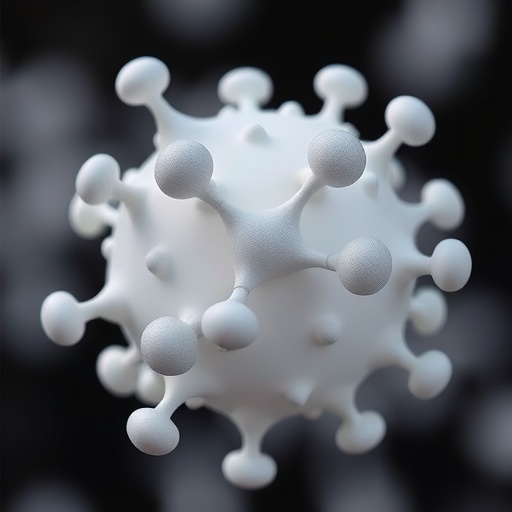In a groundbreaking study published in Nature, researchers have unveiled the intricate ways in which amino acids stabilize proteins and colloidal dispersions, elucidating a fundamental aspect of biomolecular interactions that has eluded comprehensive understanding for decades. This novel research merges theory with cutting-edge experimentation to reveal how simple small molecules like amino acids govern the self-assembly and phase behavior of complex biological macromolecules and nanoparticles, potentially revolutionizing fields from pharmaceuticals to food science.
Proteins and nanoparticles, ubiquitous in biology and materials science, often behave unpredictably in solution due to a delicate balance of attractive and repulsive forces. Understanding these interactions is vital because uncontrolled aggregation can compromise therapeutic efficacy, structural integrity, and functional longevity of protein-based formulations or colloidal suspensions. The research team approached this challenge by scrutinizing the osmotic second virial coefficient (B22), a thermodynamic parameter intimately linked to particle interactions, which encapsulates the net balance of forces shaping the stability of dispersions.
Central to the investigation was a robust theoretical framework that models colloids as patchy particles on a lattice, with each patch representing loci of potential attraction. This patchy colloid model effectively captures the complexity of surface heterogeneity inherent in proteins and engineered nanoparticles. By introducing amino acids, which may adsorb onto and mask these patches, the study revealed how the effective coordination number decreases, thereby modulating the interaction landscape. Remarkably, this adsorption process follows classical Langmuir isotherm behavior, offering a quantitative grip on the molecular interplay between small molecules and macromolecular surfaces.
Innovative experimental techniques underpinned the validation of this theory. Small-angle scattering combined with sedimentation-based methods such as size exclusion chromatography enabled precise determination of B22 under varied amino acid concentrations. Cryogenic electron tomography provided vivid three-dimensional visualization of nanoparticle dispersions, allowing the direct extraction of potentials of mean force (PMF) between particles. The PMF curves underscored the presence of multiple interaction regimes, including short-range hydrophobic attractions and long-range dipole-dipole interactions modulated by plasmonic coupling intrinsic to gold nanoparticles.
Notably, the researchers observed that the addition of amino acids consistently increased B22 values, indicative of enhanced repulsive interactions or attenuated attractions. This effect was concentration-dependent, with significant changes emerging at surprisingly low amino acid concentrations, far below those typical for hydrotrope effects. Intriguingly, the increase in B22 correlated with the fraction of amino acid coverage on the colloidal surface, establishing a direct molecular handle on stability modulation. This mechanistic insight challenges prior assertions that attributed dispersion stability to simplistic solubility effects and reframes amino acids as active, site-specific modifiers of interparticle forces.
The implications for protein stability are profound, especially in the context of formulations for therapeutic proteins, where aggregation poses major obstacles. By harnessing the selectivity and affinity of individual amino acids for protein surfaces, the study presents a path to finely tune solution behavior without resorting to harsh chemical additives or extreme environmental changes. Moreover, the universality of the theoretical model means that this approach can be generalized across a spectrum of biologics and colloidal systems, heralding broad applicability.
Complementing theoretical predictions, fluorescence quenching experiments quantified the binding constants and number of binding sites of amino acids to lysozyme, corroborating the transient yet functionally significant adsorption of amino acids on protein surfaces. Dynamic light scattering and analytical ultracentrifugation further characterized changes in protein aggregation states and sedimentation profiles under the influence of amino acids. These multifaceted approaches collectively build a compelling case for the molecular basis of stabilization via selective surface masking.
Extending beyond proteins, gold nanoparticles functionalized with mixed ligand shells exhibited modulation of plasmonic coupling-derived interaction peaks upon amino acid addition. This highlights the versatile applicability of amino acid-mediated control over nanoscale systems where electrostatic and dipolar couplings are critical. The ability to attenuate long-range attractive forces while preserving steric and electrostatic repulsion provides a refined toolkit to engineer colloidal stability for applications in sensing, catalysis, and biomedicine.
Biological relevance was underscored by cellular experiments demonstrating that amino acid-mediated stabilization influences phase transition behaviors linked to protein condensation and stress granule formation. At elevated temperatures, proline supplementation was shown to mitigate aggregation and preserve native protein distribution within cell cultures, hinting at physiological implications in proteostasis and cellular stress responses. This biological angle broadens the impact of the findings, connecting molecular-scale interactions to macroscopic cellular function.
Fundamentally, this work rests on a meticulous mathematical foundation that relates free energy changes derived from mean-field theories to measurable virial coefficients. The elegant linkage between microscopic adsorption equilibria and macroscopic dispersion behavior underscores the predictive power of the developed model. By allowing site-specific adsorption and heterogeneous patch affinities, the framework embraces real-world complexity while remaining computationally tractable.
In summary, this study unlocks a nuanced mechanistic understanding of how amino acids modulate protein and colloidal dispersion stability. It challenges conventional paradigms by positioning small molecule adsorption as a critical determinant of interparticle interaction landscapes, rather than a mere background effect. The integration of advanced experimental techniques with sophisticated theoretical models offers a template for future research aimed at controlling biomolecular assembly processes with molecular precision.
The insights gained here open exciting new avenues for designing tailor-made stabilizers for protein therapeutics, colloidal materials, and nanomedicine. By exploiting simple building blocks such as amino acids to regulate intricate molecular forces, scientists can envision a future where particulate stability is modulated predictably and sustainably. This pioneering work paves the way for innovation across biotechnology, materials science, and medicine, affirming the profound influence of molecular-scale interactions on macroscopic material properties.
Subject of Research: Stabilization mechanisms of proteins and colloidal dispersions mediated by amino acid adsorption.
Article Title: Stabilizing effect of amino acids on protein and colloidal dispersions.
Article References:
Mao, T., Xu, X., Winkler, P.M. et al. Stabilizing effect of amino acids on protein and colloidal dispersions. Nature (2025). https://doi.org/10.1038/s41586-025-09506-w
Image Credits: AI Generated




